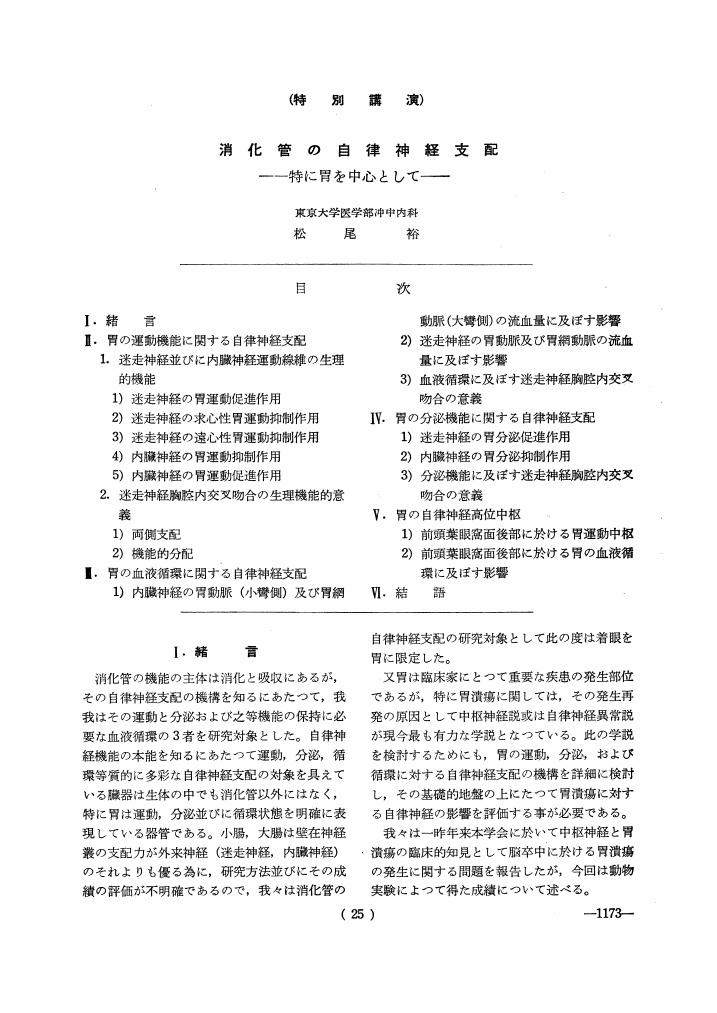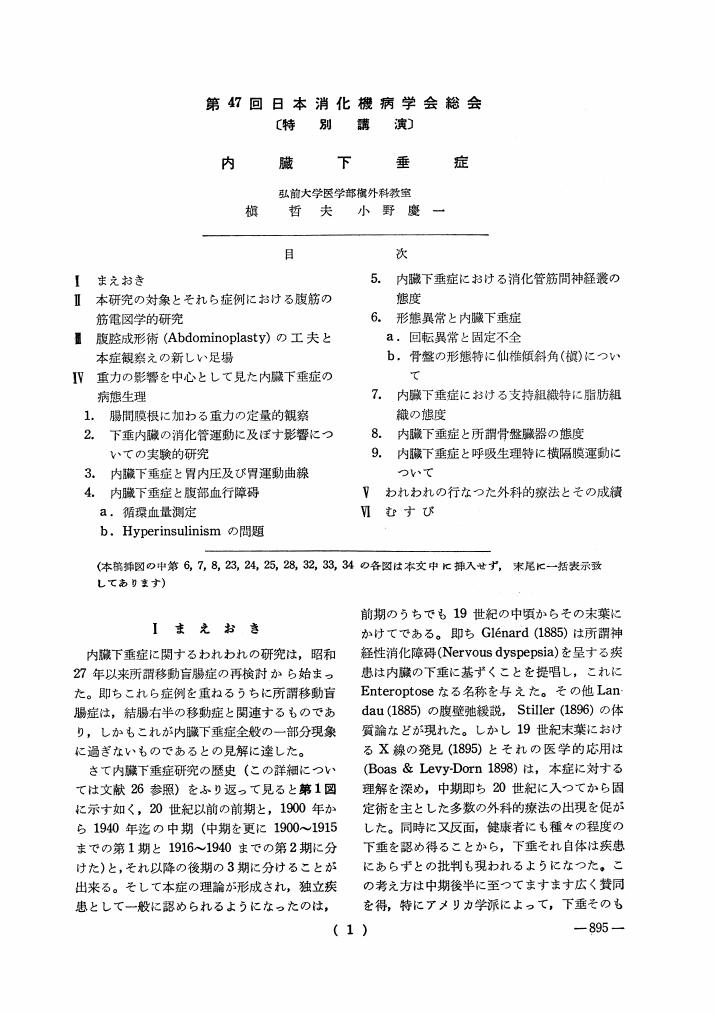4 0 0 0 OA 消化管の自律神経支配 特に胃を中心として
- 著者
- 松尾 裕
- 出版者
- 財団法人 日本消化器病学会
- 雑誌
- 日本消化機病學會雜誌 (ISSN:04466586)
- 巻号頁・発行日
- vol.58, no.11, pp.1173-1179_2, 1961 (Released:2011-06-17)
1 0 0 0 OA 肝疾患に於けるクエン酸代謝の研究 (原著)
- 著者
- 太田 明生
- 出版者
- 財団法人 日本消化器病学会
- 雑誌
- 日本消化機病學會雜誌 (ISSN:04466586)
- 巻号頁・発行日
- vol.55, no.8, pp.547-562, 1958 (Released:2011-06-17)
- 参考文献数
- 21
Citrate metabolism was studied in control subjects and patients with liver diseases and nephritis, and following results were obtained.1) The plasma citrate level in fasting state was 8.6-21.3 γ/cc (average 15.8) in 42 control subjects, 11.8-60.0 γ/cc on 62 determinations in 20 patients with hepatitis, (being parallel with icteric index), 15.2-41.8 γ/cc in 24 patients with liver cirrhosis, (being parallel with severity of cirrhosis), 7.2-20.1 γ/cc (average 13.6) in 6 patients with obstructive jaundice, and 9.521.5 γ/cc (average 15.2) in 11 patients with nephritis.2) The amount of urinary citrate excreted in two hours at fasting state was 45.0 mg in control subjects and it was increased in patients with liver diseases, being parallel with its plasma level in most cases. After the intravenous administration of citrate, the amount of urinary citrate increased and its increment in two hours corresponded to 5.1-9.0% of administered citrate in control subjects, while it was greater in patients with liver diseases.3) The citrate levels in blood plasma of peripheral artery, cubital vein, hepatic vein, and renal vein were compared and the concentration gradient was found to be as follows.Cubital V.>Peripheral A.>Renal V.>Hepatic V.4) According to the citrate tolerance test (intravenous administration of 20 mg per kg. as sodium citrate), plasma citrate level in control subjects returned to the previous level in one hour, but it was delayed in patients with hepatitis and liver cirrhosis, while in patients with obstructive jauttaide and nephritis the curve was similar to that of control subjects. When 10 mg of vitamine B1 was subcutaneously injected 30 minutes prior to citrate administration, citrate metabolism was accelerated in control subjects, but not in patients with liver diseases.5) After the intravenous administration of citrate, α-ketoglutarate in blood was significantly elevated and its peak was at 15 minutes after administration in control subjects, but was at 30 minutes in patients with liver diseases.6) It may be presumed that the citrate tolerance test is a reliable method for detecting the impairment of TCA cycle in liver.
1 0 0 0 OA 胃下垂症に対する考察
- 著者
- 川島 震一
- 出版者
- 財団法人 日本消化器病学会
- 雑誌
- 日本消化機病學會雜誌 (ISSN:04466586)
- 巻号頁・発行日
- vol.58, no.9, pp.931-933, 1961 (Released:2011-06-17)
1 0 0 0 OA 内臓下垂症
- 著者
- 槙 哲夫 小野 慶一
- 出版者
- 財団法人 日本消化器病学会
- 雑誌
- 日本消化機病學會雜誌 (ISSN:04466586)
- 巻号頁・発行日
- vol.58, no.9, pp.895-907_4, 1961 (Released:2011-06-17)
- 参考文献数
- 53
1 0 0 0 OA 胃温に関する研究
- 著者
- 佐藤 俊
- 出版者
- 財団法人 日本消化器病学会
- 雑誌
- 日本消化機病學會雜誌 (ISSN:04466586)
- 巻号頁・発行日
- vol.50, no.7, pp.1-11, 1953-04-30 (Released:2011-06-17)
- 参考文献数
- 13
I have measured the stomach tenperature under several conditions of the animal and human body. Thermoelectric junction was used for this measurement. The stomach temperature is affected by the circulating blood temperature, blood quantity, blood velocity and the internal temperature of the abdomen, especially by the neighboring organ temperature and the calory of the consumed food.The stomach itself plays an important role in the regulation of body temperature. There is found also a very close relationship between the stomach secretion and the stomach temperature.
- 著者
- 百溪 三郎
- 出版者
- 財団法人 日本消化器病学会
- 雑誌
- 日本消化機病學會雜誌 (ISSN:04466586)
- 巻号頁・発行日
- vol.51, no.11, pp.439-445, 1954
Many authors have reported on the change of liver catalase activity in relation to the growth of malignant tumors in the host and to the administration of drugs or substances extracted from cancer tissues.The author found that extracts from a placenta can cause reduction of liver catalase activity in mice when injected intraperitoneally.In the experiments, seasonal fluctuations of the liver catalase activity were also observed. This fact, is important in the research of liver catalase activity.<BR>In the experiments reported in this paper, liver catalase activity was measured periodically. With intention to investigate the productino, transportation, storage and consumption of catalase in the body, catalase activity of blood and brain were also measured periodically.<BR>1) There are seasonal fluctuations in liver, blood, and brain catalase activity.Liver and blood catalase activity has stable periods in summer and winter, and unstable periods in spring and autumn. The values of liver catalase activity are higher in summer, and those of blood are higher in winter contrary to that of liver. No stable period was found in brain catalase activity and their values are higher in summer similarly to that of liver.<BR>2) In following up their correlative relations, marked nagative correlations were found at certain time in the unstable period of the liver catalase activity.<BR>3) In summing up the correlative coefficients, negative correlations were dominant between blood and liver, and posititve correlations were dominant in other cases. This fact proved to be statistically significant.
1 0 0 0 OA 正誤表
- 出版者
- 財団法人 日本消化器病学会
- 雑誌
- 日本消化機病學會雜誌 (ISSN:04466586)
- 巻号頁・発行日
- vol.55, no.8, pp.e1-e1, 1958 (Released:2011-06-17)



